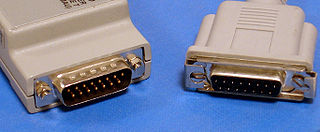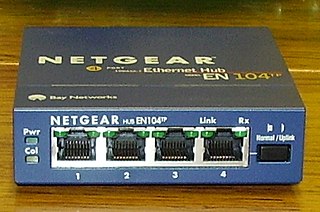
Ethernet is a family of wired computer networking technologies commonly used in local area networks (LAN), metropolitan area networks (MAN) and wide area networks (WAN). It was commercially introduced in 1980 and first standardized in 1983 as IEEE 802.3. Ethernet has since been refined to support higher bit rates, a greater number of nodes, and longer link distances, but retains much backward compatibility. Over time, Ethernet has largely replaced competing wired LAN technologies such as Token Ring, FDDI and ARCNET.

Network topology is the arrangement of the elements of a communication network. Network topology can be used to define or describe the arrangement of various types of telecommunication networks, including command and control radio networks, industrial fieldbusses and computer networks.

Apple Attachment Unit Interface (AAUI) is a mechanical re-design by Apple of the standard Attachment Unit Interface (AUI) used to connect Ethernet transceivers to computer equipment. AUI was popular in the era before the dominance of 10BASE-T networking that started in the early 1990s; AAUI was an attempt to make the connector much smaller and more user friendly, though the proprietary nature of the interface was also criticized.

In computer networking, Fast Ethernet physical layers carry traffic at the nominal rate of 100 Mbit/s. The prior Ethernet speed was 10 Mbit/s. Of the Fast Ethernet physical layers, 100BASE-TX is by far the most common.

In computer networking, Gigabit Ethernet is the term applied to transmitting Ethernet frames at a rate of a gigabit per second. The most popular variant, 1000BASE-T, is defined by the IEEE 802.3ab standard. It came into use in 1999, and has replaced Fast Ethernet in wired local networks due to its considerable speed improvement over Fast Ethernet, as well as its use of cables and equipment that are widely available, economical, and similar to previous standards. The first standard for faster 10 Gigabit Ethernet was approved in 2002.

The Attachment Unit Interface (AUI) is a physical and logical interface defined in the original IEEE 802.3 standard for 10BASE5 Ethernet and the previous DIX standard. The physical interface consists of a 15-pin D-subminiature connection that provides a path between an Ethernet node's physical signaling and the Medium Attachment Unit (MAU), sometimes also known as a transceiver. An AUI cable may be up to 50 metres long, although frequently the cable is omitted altogether and the MAU and medium access controller MAC are directly attached to one another. On Ethernet implementations without separate MAU and MAC, the AUI is omitted.

Small Form-factor Pluggable (SFP) is a compact, hot-pluggable network interface module format used for both telecommunication and data communications applications. An SFP interface on networking hardware is a modular slot for a media-specific transceiver, such as for a fiber-optic cable or a copper cable. The advantage of using SFPs compared to fixed interfaces is that individual ports can be equipped with different types of transceivers as required.

A Medium Attachment Unit (MAU) is a transceiver which converts signals on an Ethernet cable to and from Attachment Unit Interface (AUI) signals.

Cabletron Systems, Inc., was a manufacturer of networking computer equipment throughout the 1980s and 1990s primarily based in Rochester, New Hampshire, in the United States. They also had manufacturing facilities in Ironton, Ohio, and in Ireland.
SynOptics Communications was a Santa Clara, California-based early computer network equipment vendor from 1985 until 1994. SynOptics popularized the concept of the modular Ethernet hub and high-speed Ethernet networking over copper twisted-pair and fiber optic cables.

An Ethernet hub, active hub, network hub, repeater hub, multiport repeater, or simply hub is a network hardware device for connecting multiple Ethernet devices together and making them act as a single network segment. It has multiple input/output (I/O) ports, in which a signal introduced at the input of any port appears at the output of every port except the original incoming. A hub works at the physical layer of the OSI model. A repeater hub also participates in collision detection, forwarding a jam signal to all ports if it detects a collision. In addition to standard 8P8C ("RJ45") ports, some hubs may also come with a BNC or an Attachment Unit Interface (AUI) connector to allow connection to legacy 10BASE2 or 10BASE5 network segments.

Perle Systems is a technology company that develops and manufactures serial to Ethernet, fiber to Ethernet, I/O connectivity, and device networking equipment. These types of products are commonly used to establish network connectivity across multiple locations, securely transmit sensitive information across a LAN, and remotely monitor and control networked devices via out-of-band management.

The physical-layer specifications of the Ethernet family of computer network standards are published by the Institute of Electrical and Electronics Engineers (IEEE), which defines the electrical or optical properties and the transfer speed of the physical connection between a device and the network or between network devices. It is complemented by the MAC layer and the logical link layer.

Fiber-optic communication is a method of transmitting information from one place to another by sending pulses of infrared or visible light through an optical fiber. The light is a form of carrier wave that is modulated to carry information. Fiber is preferred over electrical cabling when high bandwidth, long distance, or immunity to electromagnetic interference is required. This type of communication can transmit voice, video, and telemetry through local area networks or across long distances.
40 Gigabit Ethernet (40GbE) and 100 Gigabit Ethernet (100GbE) are groups of computer networking technologies for transmitting Ethernet frames at rates of 40 and 100 gigabits per second (Gbit/s), respectively. These technologies offer significantly higher speeds than 10 Gigabit Ethernet. The technology was first defined by the IEEE 802.3ba-2010 standard and later by the 802.3bg-2011, 802.3bj-2014, 802.3bm-2015, and 802.3cd-2018 standards. The first succeeding Terabit Ethernet specifications were approved in 2017.

A fiber media converter is a simple networking device that makes it possible to connect two dissimilar media types such as twisted pair with fiber optic cabling. They were introduced to the industry in the 1990s, and are important in interconnecting fiber optic cabling-based systems with existing copper-based, structured cabling systems. They are also used in metropolitan area network (MAN) access and data transport services to enterprise customers.

Accton Technology Corporation is a Taiwanese company in the electronics industry that primarily engages in the development and manufacture of networking and communication solutions, as an original equipment manufacturer (OEM) or original design manufacturer (ODM) partner.
Terabit Ethernet or TbE is Ethernet with speeds above 100 Gigabit Ethernet. 400 Gigabit Ethernet and 200 Gigabit Ethernet standards developed by the IEEE P802.3bs Task Force using broadly similar technology to 100 Gigabit Ethernet were approved on December 6, 2017. In 2016, several networking equipment suppliers were already offering proprietary solutions for 200G and 400G.
Classic Ethernet is a family of 10 Mbit/s Ethernet standards, which is the first generation of Ethernet standards. In 10BASE-X, the 10 represents its maximum throughput of 10 Mbit/s, BASE indicates its use of baseband transmission, and X indicates the type of medium used. The first standard for Fast Ethernet, was approved in 1995.
Optelecom-NKF, Inc. is an American company that designs, manufactures, and markets high-bandwidth communications products, financial market data information, and business video systems.














